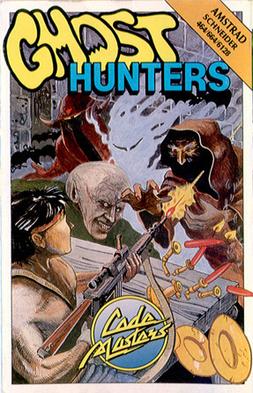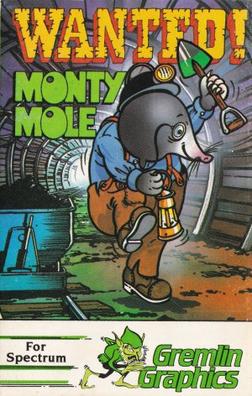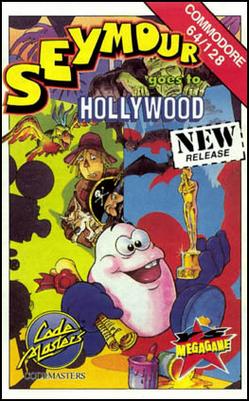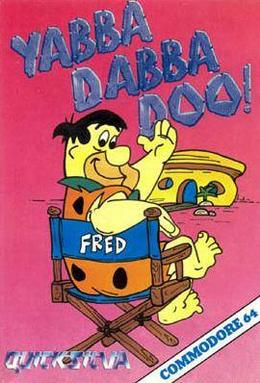
The ZX Spectrum is an 8-bit home computer that was developed by Sinclair Research. It was released in the United Kingdom on 23 April 1982, and became Britain's best-selling microcomputer.

Sabre Wulf is an action-adventure game released by British video game developer Ultimate Play the Game for the ZX Spectrum home computer in 1984. The player navigates the pith-helmeted Sabreman through a 2D jungle maze while collecting amulet pieces to bypass the guardian at its exit. The player does not receive explicit guidance on how to play and is left to decipher the game's objectives through trial and error. Sabreman moves between the maze's 256 connected screens by touching the border where one screen ends and another begins. Each screen is filled with colourful flora, enemies that spawn at random, and occasional collectibles.

Ghostbusters is a licensed game by Activision based on the film of the same name. It was designed by David Crane and released for several home computer platforms in 1984, and later for video game console systems, including the Atari 2600, Master System and Nintendo Entertainment System. The primary target was the Commodore 64 and the programmer for the initial version of the game was Adam Bellin. All versions of the game were released in the USA except for the Amstrad CPC and ZX Spectrum versions, which were released only in Europe, and the MSX version, which was released only in Europe, South America, and Japan.

The Lords of Midnight is an epic fantasy video game combining aspects of wargames and graphic adventures, written by Mike Singleton and originally released in 1984 for the ZX Spectrum. Very well received from the beginning, it was soon converted for the Amstrad CPC and Commodore 64. The game featured an innovative 3-D effect that Singleton called landscaping, which served to bring the player into the game much more than usual. The Lords of Midnight is often named with Elite as among the top role-playing games of the 1980s.

The Hobbit is an illustrated text adventure computer game released in 1982 for the ZX Spectrum home computer and based on the 1937 book The Hobbit, by J. R. R. Tolkien. It was developed at Beam Software by Philip Mitchell and Veronika Megler and published by Melbourne House. It was later converted to most home computers available at the time including the Commodore 64, BBC Micro, and Oric computers. By arrangement with the book publishers, a copy of the book was included with each game sold.

Raid Over Moscow is a computer game by Access Software published in Europe by U.S. Gold for the Commodore 64 in 1984 and other microcomputers in 1985-1986.

Mabinogi is a massively multiplayer online role-playing game released by Nexon, and developed by devCAT studio. The name of the game is taken from the Welsh word Mabinogi, a Welsh anthology of legend, and the settings for the game are loosely based on Welsh mythology.

Ghost Hunters is a platform game written by the Oliver twins for the Amstrad CPC and published by Codemasters in January 1987. It was also converted and released for the ZX Spectrum (1987) and Commodore 64 (1989) platforms. The game combines platform-style action with shooting gameplay similar to that found in the game Operation Wolf. The game is the second release by the Oliver twins, published when they were just seventeen years old and still going to school. It was conceived as a sequel to their first commercially successful game, Super Robin Hood, although it has little to do with this game other than using a modified version of its engine. The twins have credited the film Ghostbusters and the cartoon series Scooby-Doo for influencing the game.

Doomdark's Revenge is a role-playing and wargame video game developed by Mike Singleton and published by Beyond Software for the ZX Spectrum in 1984. It is a sequel to Singleton's 1984 seminal The Lords of Midnight and has similar game mechanics but adds more detail and complexity with the number of characters and locations increased.

Pyjamarama is a video game for the ZX Spectrum, Amstrad CPC, and the Commodore 64. It features Wally Week as the central character and is the second of a series of games featuring Wally and/or members of his family. It was published by Mikro-Gen. Starting in July 1986, Your Sinclair magazine published a monthly comic strip based on the character.
Magic Knight is a computer game character and game franchise created by freelance programmer David Jones originally for the 1985 game Finders Keepers on the Mastertronic budget label. Finders Keepers is a flip-screen platform game released on the ZX Spectrum, Amstrad CPC, MSX and Commodore 64. The game spawned three additional sequels on the Mastertronic Added Dimension budget label: Spellbound (1985), Knight Tyme (1986) and Stormbringer (1987). The three sequels are far less action-orientated, being effectively graphic adventure games using a basic menu system ("Windimation") for Magic Knight to interact with characters and items instead of typed commands.

Wanted: Monty Mole is a platform video game published in July 1984 for the ZX Spectrum and Commodore 64 home computers. It is the first game released by Gremlin Graphics and the first game in the Monty Mole series. Monty Mole is a fictional mole created by Ian Stewart, the director of the company.

Brataccas is a science fiction action-adventure game released in 1985 for the Amiga, Atari ST, and Macintosh. It was the first game published by Psygnosis. Brataccas is built on the remains of the much-hyped vaporware project Bandersnatch, which was partially developed by Imagine Software. The storied tale of the game's development led to close press attention in the UK computer market. When Brataccas finally shipped, this attention resulted in considerable coverage in the computer press. It was generally reviewed poorly due to significant control problems, although the graphics were widely praised.
Mikro-Gen was a UK software company based in Bracknell, Berkshire that produced games for home computers in the early to mid-1980s.
Thorn EMI Computer Software was a British video games software house set up in the early 1980s as part of the now-defunct British conglomerate Thorn EMI. They released a number of games in the early 1980s, initially for the Atari 8-bit family, and later for the ZX Spectrum, Commodore 64 and VIC-20 computers. In 1984, the Thorn EMI name was dropped in favour of Creative Sparks as the company were reportedly unhappy with their image in the video games market. A budget label, Sparklers, was created in early 1985 to publish titles at £2.50. Later in 1985, Creative Sparks, Sparklers and the distribution company, Creative Sparks Distribution (CSD) gained independence from Thorn EMI after a management buyout.

Equinox is an action video game released by Mikro-Gen in 1986 for the ZX Spectrum, Amstrad CPC, and Commodore 64.

Three Weeks in Paradise is a video game released in 1986 by Mikro-Gen for the ZX Spectrum and Amstrad CPC platforms. It is the last action-adventure platform in the Wally Week series.

Francisco "Paco" Menéndez (1965–1999) was a Spanish computer game programmer who wrote games for 8-bit computers. His most famous work is La abadía del crimen which is regarded as one of the best games made for 8-bit computers.

Seymour Goes to Hollywood, also known as Seymour at the Movies, is a platform and adventure game developed by Big Red Software and originally published in Europe by Codemasters in 1991. Players control Seymour, a small potato-like creature who wishes to be a film star. The film's script has been locked in a safe, meaning Seymour must solve puzzles by collecting and using objects scattered throughout the game in order to progress, ultimately retrieving the script and allowing filming to start.

Yabba Dabba Doo! is a 1986 video game developed by British studio Taskset and published by Quicksilva for the Amstrad CPC, Commodore 64 (C64), and ZX Spectrum. It is based on the television series The Flintstones and is the first Flintstones video game.

















